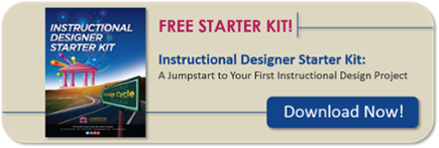
Photo by: Annie Spratt via Unsplash
Instructional Designers are constantly faced with the challenge of putting together solid performance-based training that sets learners up for success on the job. Their real-world circumstances are often less than ideal as they are consistently asked to work their magic with tight and unrealistic constraints. As training professionals, we know there is no magic wand, but we do have choices. One of those choices is blended learning. It offers the instructional designer a variety of strategies to choose from to help solve the complexities of the work environment’s training needs. There is no perfect blend of strategies, but there is a 3-step process we explore in our Blended Learning workshop that helps simplify the decision-making process.
Step 1: Identify Constraints
Before you choose a core strategy, like traditional instructor-led training or e-learning, you must first identify the instructional design constraints you are facing (e.g. time, budget, organizational mandates/policies, technical, design, etc.). This is a critical first step.
Step 2: Select Strategy
Once you have identified your constraints, it is time to consider the best core strategy (or strategies) that is most feasible for the type of content you are designing for. Will it be a traditional strategy, an e-learning strategy, or a combination? Not only do you need to assess the type of content, you will also need to consider other key factors such as the location of the learners, available resources, and deadlines, along with their implications.
Step 3: Consider Performance Support Activities
Unfortunately, we don’t live in an ideal world. Due to tight constraints, the instructional designer may need to incorporate Performance Support Activities (PSA’s) to support the core training strategy solution. While there’s a wide variety of PSA’s, some of the most common are coaching sessions, assigned reading, and group discussions and assessments.
Remember, there is no perfect blend. If you would like to explore best practices and dig a little deeper into the available strategies and options, I encourage you to register for our Blended Learning workshop. You may discover the ideal blend for you!
Note: This post is part of a workshop intersession activity. As such, it is monitored in a slightly different manner than the other blog posts on our website. If you are not a participant in the applicable workshop, but have a question you would like answered, please feel free to contact us.


64 Responses to “A 3-Step Decision-Making Process for Blended Learning”
Blended learning is essentially a salad bar or buffet line approach to learning. The job of a trainer is to understand the constraints when designing the training similar to if you filled up a plate for someone at a buffet, you would first check for their food allergies (constraints). The approach lends itself to increased flexibility and outreach to spread learning across the various audiences. Utilizing the prioritization matrix really helps take it to the next level to make sure what you are building is what you need. Langevin’s three step approach is an easy model to follow.
The structured approach is really helpful, especially for newer designers. I have found the structured approach to instructional design that Langevin teaches is an intuitive and approachable method to provide some rigor to your planning process.
The Blended Learning workshop presents an expansion to the 3-step decision process for blended learning presented here, by providing additional tools, checklists, and guidance that assists the instructional designer on defining critical constraints, selecting the core strategy, and identifying the appropriate PSA’s to deliver the best learning solution. Remember that performance-based training has three core components as performance, application, and feedback elements.
Blended learning provides endless possibilities and flexibility in presenting content. While learners self-pace their e-learning and enjoy flexibility with an online component, complex topics and challenging applications can be presented in the classroom under instructor’s guidance. This approach can efficiently and quickly deliver training to a broad audience, especially to adult learners.
Currently enrolled in the Blending Learning course. First day and I’m amazed at what I learned, with more to come which I am looking forward to. Really, can’t wait to apply all the principles and various concepts to create that perfectly blended course.
Blended learning allows you to develop and deliver a more custom and relevant training plan.
As someone with a lot of content to train, the blended learning approach is teaching me to organize my training materials and training methods in a more meaningful way. It is giving me a new perspective and insights on how to train effectively.
Blended learning is a great approach if time constraints allow. When on a tight development deadline, it’s difficult to move tasks to an asynchronous module as the development time for self-paced learning is much longer than that of a traditional ILT.
The Blended Learning approach seems to provide more flexibility and variety. This helps us reach more people with different learning styles as well as increasing the chance of keeping our learners engaged.
Blended learning allows the instructor to find more feasible ways to administer the training needed. In the unpredictable world that we live in today, the ability to have training in multiple formats and have different aspects to it, for example e-learning, gives the trainer more flexibility when designing a course.